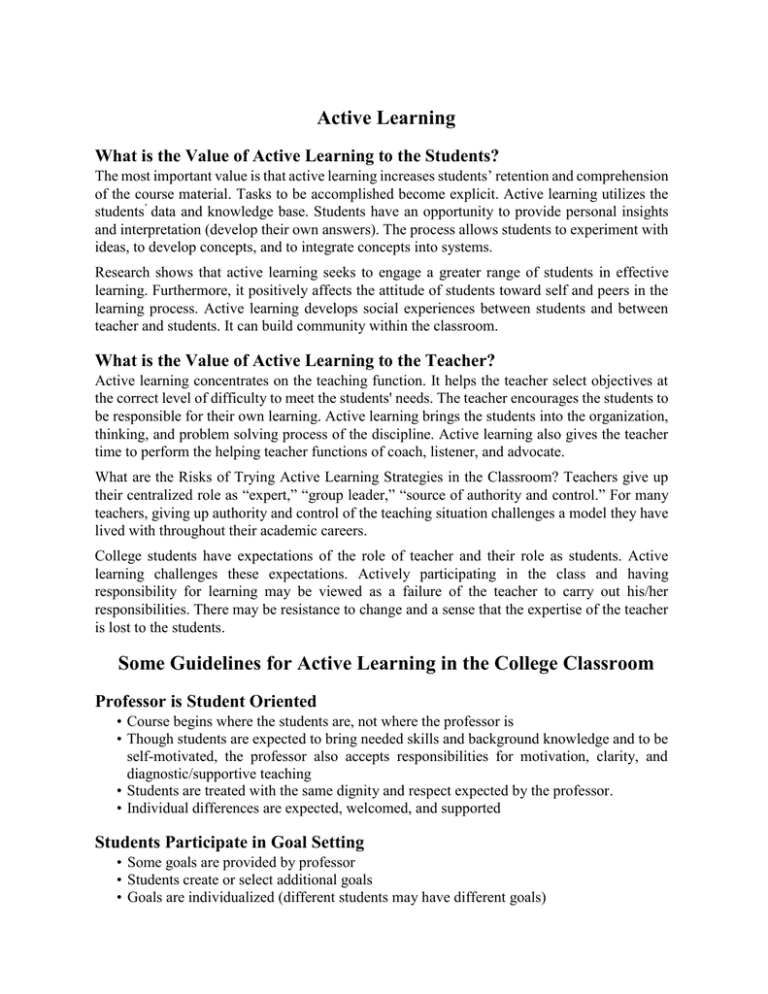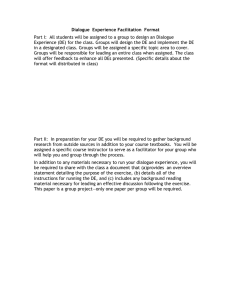Active Learning Guidelines - Faculty Center for Teaching and Learning
advertisement

Active Learning What is the Value of Active Learning to the Students? The most important value is that active learning increases students’ retention and comprehension of the course material. Tasks to be accomplished become explicit. Active learning utilizes the students’ data and knowledge base. Students have an opportunity to provide personal insights and interpretation (develop their own answers). The process allows students to experiment with ideas, to develop concepts, and to integrate concepts into systems. Research shows that active learning seeks to engage a greater range of students in effective learning. Furthermore, it positively affects the attitude of students toward self and peers in the learning process. Active learning develops social experiences between students and between teacher and students. It can build community within the classroom. What is the Value of Active Learning to the Teacher? Active learning concentrates on the teaching function. It helps the teacher select objectives at the correct level of difficulty to meet the students' needs. The teacher encourages the students to be responsible for their own learning. Active learning brings the students into the organization, thinking, and problem solving process of the discipline. Active learning also gives the teacher time to perform the helping teacher functions of coach, listener, and advocate. What are the Risks of Trying Active Learning Strategies in the Classroom? Teachers give up their centralized role as “expert,” “group leader,” “source of authority and control.” For many teachers, giving up authority and control of the teaching situation challenges a model they have lived with throughout their academic careers. College students have expectations of the role of teacher and their role as students. Active learning challenges these expectations. Actively participating in the class and having responsibility for learning may be viewed as a failure of the teacher to carry out his/her responsibilities. There may be resistance to change and a sense that the expertise of the teacher is lost to the students. Some Guidelines for Active Learning in the College Classroom Professor is Student Oriented • Course begins where the students are, not where the professor is • Though students are expected to bring needed skills and background knowledge and to be self-motivated, the professor also accepts responsibilities for motivation, clarity, and diagnostic/supportive teaching • Students are treated with the same dignity and respect expected by the professor. • Individual differences are expected, welcomed, and supported Students Participate in Goal Setting • Some goals are provided by professor • Students create or select additional goals • Goals are individualized (different students may have different goals) Multi-level Outcomes are Expected; Learning includes: • • • • Facts and information Concepts and understanding Processes and applications Metacognition and reflections Sample Active Learning Techniques Think-Pair-Share Students reflect on a question or issue for one or two minutes, noting factors, ideas, strategies, etc., that pertain to the topic. At the end of the designated time period, students turn to a peer and work together to formulate a correct response or provide an overview of the information. Pairs then share their answer or overview with a large group or with the entire class. Meeting of the minds panel Students role-play different figures who bring alternative points of view to the discussion topic. Set up the roles in advance and provide students with hints regarding critical pieces of information that will be critical to the character's success in the discussion. Fishbowls A small number of students must respond to questions distributed in a previous class session. These students become experts in a given field and supplement the teacher as a source of information and feedback. Cold-calling A single student must share with the class his/her conclusion supported by reasons and evidence. This technique can be used as an individual homework assignment for which students receive a question/issue in advance and have the opportunity to prepare answers. It can also be used as a group activity during which students compare evidence and prepare reasons without knowing who will be called upon to provide the final justification. Case Study/Discussion Method An open ended story or case study provides a vehicle for analysis, criticism, and reaching conclusions. Reciprocal Peer Questioning Students prepare questions on a lecture, reading, experiment, etc. that they share with a group and discuss to answer with supporting evidence. Each group chooses one question to share with the large group as a discussion starter. Conference Style Learning Students read materials that build on previous class activities and prepare key ideas as well as questions for debate. The teacher functions as a facilitator, time keeper, and discussion guide, adding strategic questions to keep the discussion going. Students perform as experts on a given issue. Classroom Climate is Collegial, Supportive, and Spontaneous • Everyone knows and uses everyone else's name • Everyone knows (and respects) everyone else’s background, current position, interests, goals, etc. • Professor does no more than 50% of the talking and no more than 75% of the decision making • Discussion, group work, and active participation is encouraged and expected Activities are Problem-Centered and Student-Driven • Students are expected to be active learners • Course is built upon real problems that relate to student goals and interests • Some easier problems are dealt with early in the course and are used to provide paradigms and activity models • Students have some flexibility in problem selection • Busy work and unnecessary repetition are minimized • Whenever possible, students work at own pace and on own schedule • Students are encouraged/required to work together in groups and to provide suggestions, feedback, and support to one another Assessment is Continuous and Supportive • Formative developmental feedback is emphasized over summative grades • Professor's comments focus upon success and suggestions for improvement rather than upon mistakes and corrections • Students are allowed/expected to revise and resubmit work that does not meet expected standards, and summative grades are based upon revised work • Professor's role is primarily to help students toward success, not merely to point out their shortcomings; students should build pride in accomplishments and existing abilities • All assessment should be criterion-referenced rather than normative • Assessment involves facts/concepts/applications • Assessment is often authentic Teaching is Developmental rather than Directive or Presentational • Students are active creators of knowledge, not passive receivers of information • Multiple answers (rather than one right answer) are often accepted • Emphasis is upon understanding and application rather than upon memorization and repetition • Professor teaches disciplinary (subject area) methods and provides access to information; students gather, organize, and use information • Professor helps students to understand learning styles and methods and help students to identify and remediate any personal learning problems • The methods of the discipline are as (or more) important than the content • Professor guides but does not entirely dictate task identification, activities sequencing, and working strategies • Newer technologies, media, content, and methods are emphasized • Students are allowed broad flexibility and encouraged toward self-direction • Professor emphasizes and teaches metacognition Dialogue Analysis Students receive written dialogues to analyze. In small groups, students must identify the different viewpoints of each participant in the dialogue, analyzing the discussion for biases, presence or exclusion of important evidence, alternative interpretations, misstatement of facts, and errors in reasoning. Each group must decide which view is the most reasonable. After coming to a conclusion, each group can act out their dialogue while offering a critical analysis of the key points and successes. Spontaneous Group Dialogue One group of students are assigned roles to play in a discussion (such as leader, information giver, opinion seeker, and disagreer). Four observer groups are formed with the functions of determining what roles are being played by whom, identifying biases and errors in thinking, evaluating reasoning skills, and examining ethical implications of the content. Ambiguity Provide students with conflicting information that they must think their way through in order to create a response that can be justified.

